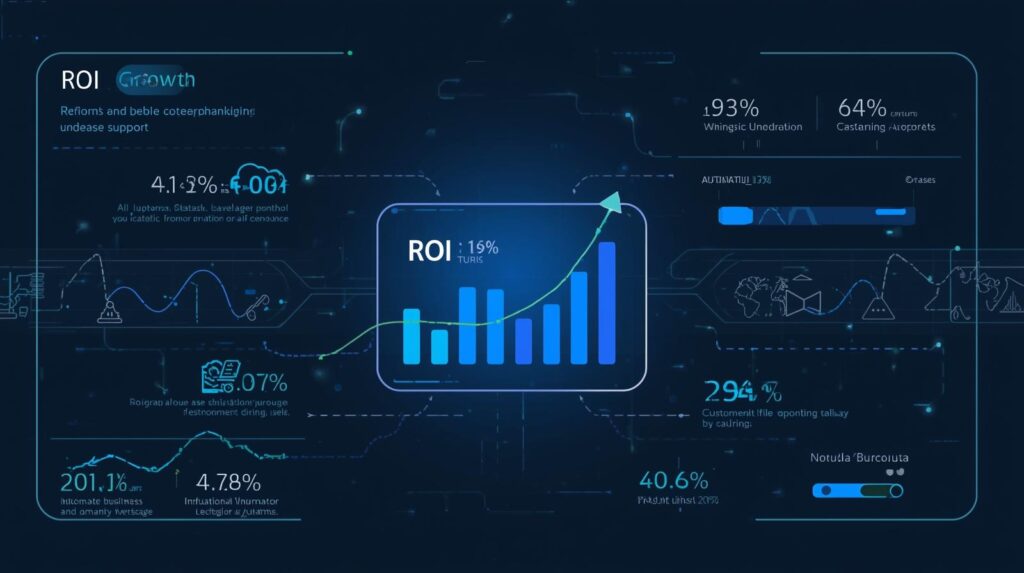As the leader of a company, you have probably heard “Go Digital!” several times and may have even implemented it by now. But the first question that comes to mind is “What result would we achieve and how fast?”.

Companies have no choice but to embrace digital transformation if they want to remain head-to-head in the competition with their competitors and draw in more customers.
And despite investing millions and billions in digital initiatives, companies still struggle to properly measure their Return on Investment (ROI). That is why, without a proper strategy, technique, and measurement, it would be like playing with fire.
In this article, we are going to explain all about ROI, the important KPI’s, and a roadmap to help you save time and value.
What is the ROI of Digital Transformation?
“The ROI of digital transformation refers to the measurable benefits an organization gains from adopting digital technologies, encompassing financial savings, increased efficiency, and enhanced customer satisfaction.”
In simple terms, it can be explained as:
ROI = (Total Benefits − Total Costs) ÷ Total Costs
Don’t just focus on productivity when looking at ROI; it should show the value of your business gains, reduced risks and costs, and better customer experience.
Direct and Indirect Value:
Direct (measurable) value:
- Labor hours saved
- Lower infrastructure/TCO (Total Cost of Ownership)
- Reduced error rates
- Conversion uplift
- Churn reduction
- Faster cycle times
- Fewer tickets.
Indirect (Strategic) value:
- Improved NPS (Net Promoter Score)/CSAT (Customer Satisfaction Score)
- Brand trust
- Analytics maturity
- Resilience
- Digital trust/cybersecurity posture that protects revenue.
Three Types of ROI in Digital Transformation
To measure ROI effectively, you first need to know where the value of digital transformation lies, and these are:
Operational ROI:
This is when technology helps businesses save time and effort by automating routine tasks and cutting down on manual work. With this, companies can lower costs and get more done with the same resources.
Example:
Instead of manually scheduling meetings and sending reminders, a digital calendar tool can automatically handle such tasks. This reduces mistakes and saves time so that the employees can focus more on important tasks like customer service and planning projects.
Customer Experience ROI:
Businesses can respond faster and provide services quickly by using tools like chatbots and self-service portals. This gives customers more ways to connect. When a customer is happy with the service, they come back more often and stay for longer.
Example:
A clothing store’s app remembers the customer’s past purchases and suggests products that align with the past purchases. This way, the experience feels more personal and the service is faster.
Strategic ROI:
Owning a business means you need to have a good strategy. And strategy in ROI means investing in tools that would scale your business –like cloud platforms, mobile-friendly apps, and AI-powered analytics.
This strategy helps you to grow your business over time and stay ahead in the competition.
Example:
A retail chain moving its systems to the cloud so it can quickly open new stores or launch an online shop without rebuilding everything from scratch.
Why it’s Important to Measure Digital Transformation ROI
Measuring the ROI of digital transformation isn’t just about costs and savings. It proves whether your strategy is working, helps secure future funding, and shows where improvements are needed.
Companies that track ROI properly are twice as likely to succeed because they can make smarter decisions, use resources better, and clearly show value.
The hard part is that digital transformation is ongoing—it’s not a one-time project. It involves new ways of working, cultural changes, and long-term shifts, which makes ROI harder to measure.
A CFO-ready measurement framework
1. Scope and baseline:
- Make a list of projects you are tracking. For example: moving to cloud, updating CRM, and adding AI tools.
- Record your “before” numbers, like costs, time taken, error rates, customer satisfaction, sales per employee, etc.
- Assign someone for each department (sales, service, finance) so someone is accountable for tracking results.
2. Quantify benefits from all angles:
Don’t just count quick wins, look at the four value areas:
- Revenue growth: more sales, upselling, faster onboarding.
- Cost savings: fewer manual hours, lower system costs, less rework.
- Flexibility: systems that make it easier and cheaper to add future projects.
- Risk reduction: avoiding cyberattacks, fines, or costly mistakes.
3. Choose metrics & KPIs that map to outcomes:
Choose the right KPI’s (Key Performance Indicator) for a better business outcome.
- Efficiency: faster processes, fewer delays, more automation.
- Customer experience: satisfaction scores, adoption of digital tools, conversions.
- Financials: payback period, cost savings, profit margin improvements.
- Workforce: time saved per employee, fewer tickets, easier access to information.
Check the results every few months and annually, because the benefits of digital transformation usually grow bigger over time as more people start using the new systems.
4. Calculate ROI with payback and NPV:
- Payback period = how many months until you break even.
- NPV/IRR = ways to show long-term financial value, adjusted for time.
- Sensitivity testing = what happens if adoption is slower or benefits are smaller?
5. Build a value-realization operating rhythm:
- Review results with finance every month.
- Utilize dashboards or integrate ERPs to track progress in real-time.
- Include costs for security and compliance up front, so that there are no surprises later.
Quick Playbook: How to Get the Best ROI from Digital Transformation
1. Connect to business goals (not just tech):
- Always link projects to real business outcomes.
- Example:
“Cut order processing time by 25%” or “Increase online sales by 2%.”
2. Start with quick wins.
- Focus on projects that show results fast (90–120 days).
- Examples:
- Automating request approvals.
- Adding self-service FAQs or chat.
- Using AI tools to speed up sales proposals.
3. Track results from the start.
- Build measurement into your workflows.
- Track things like:
- Time before vs. after automation.
- Conversion rates with/without new tools.
- Hours saved, calculated with finance.
4. Don’t forget hidden costs.
- Don’t only count benefits—also include risk savings.
- Example: avoided downtime, compliance fines, or cyberattack costs.
- Gartner recommends always including security and compliance measures in ROI, so you don’t face surprise costs later.
5. Focus on adoption, not just features.
- A tool only pays off if people actually use it.
- Invest in training, in-app help, and change management.
6. Tell a clear story to leadership.
- Use numbers and real stories.
- Share customer feedback, employee improvements, and future opportunities unlocked.
Example of ROI Calculation
Year 1 – Costs:
- Cloud + software subscriptions: $250,000
- Setup & training: $180,000
- Security & compliance upgrades: $70,000
- Total Costs: $500,000
Year 1 – Benefits:
- Automated support (fewer tickets): $108,000 saved
- Faster operations (time savings): $216,000 saved
- Higher sales conversion: $25,000 gained
- Reduced downtime risks: $75,000 saved
- Total Benefits: $424,000
ROI (Year 1):
- ($424k – $500k) ÷ $500k = −15% (a loss in the first year).
Year 2 – With steady benefits & lower costs:
- Benefits: $560,000
- Costs: $200,000
- ROI: +180%
- Payback: ~16 months
This example tells exactly why multi-year thinking is important. Returns will usually start small or even in negatives, but then grow when adoption is stabilized.
Common Pitfalls—and How to Avoid Them
1. Not checking the starting point:
It’s very important that you record your current stats before making any changes so that you can later compare it with your results.
2. Using tools that are not adopted:
Implementing new features is useless if employees and customers are not adopting them. Keep track of what is used and provide training to boost adoption.
3. Focusing on only cutting costs:
Reducing costs is essential, but not enough. Enhance customer satisfaction and flexibility, while reducing risk factors. These are what bring true value in the long run.
4. Ignoring data and AI:
Majority of the value today comes from analytics, cloud, and AI. So don’t leave them out of your roadmap.
Conclusion
Digital transformation ROI is not just about numbers; it’s about proving that your investment in technology is creating real business value. From reducing costs and risks to improving customer experience and scaling future growth, ROI shows whether your strategy is working.
The key is to measure consistently, link results to business goals, and think long term. Companies that do this are far more likely to succeed in today’s competitive digital economy.
Still Stuck On What To Do?
The journey of digital transformation might be ongoing, but the results yielded will be worth it. By starting with quick wins, tracking progress, and focusing on adoption, your business can steadily increase ROI and secure long-term growth.
If you’re unsure where to begin or how to measure results, consider partnering with experts like Largify Solutions. With experience in ERP, CRM, cloud, and AI-powered tools, Largify helps businesses turn digital investments into measurable outcomes.
The faster you align digital projects with business goals, the sooner you’ll see real ROI. Don’t just go digital—go digital with purpose.
So don’t wait for the right time, take action now! And book a free consultation today!

